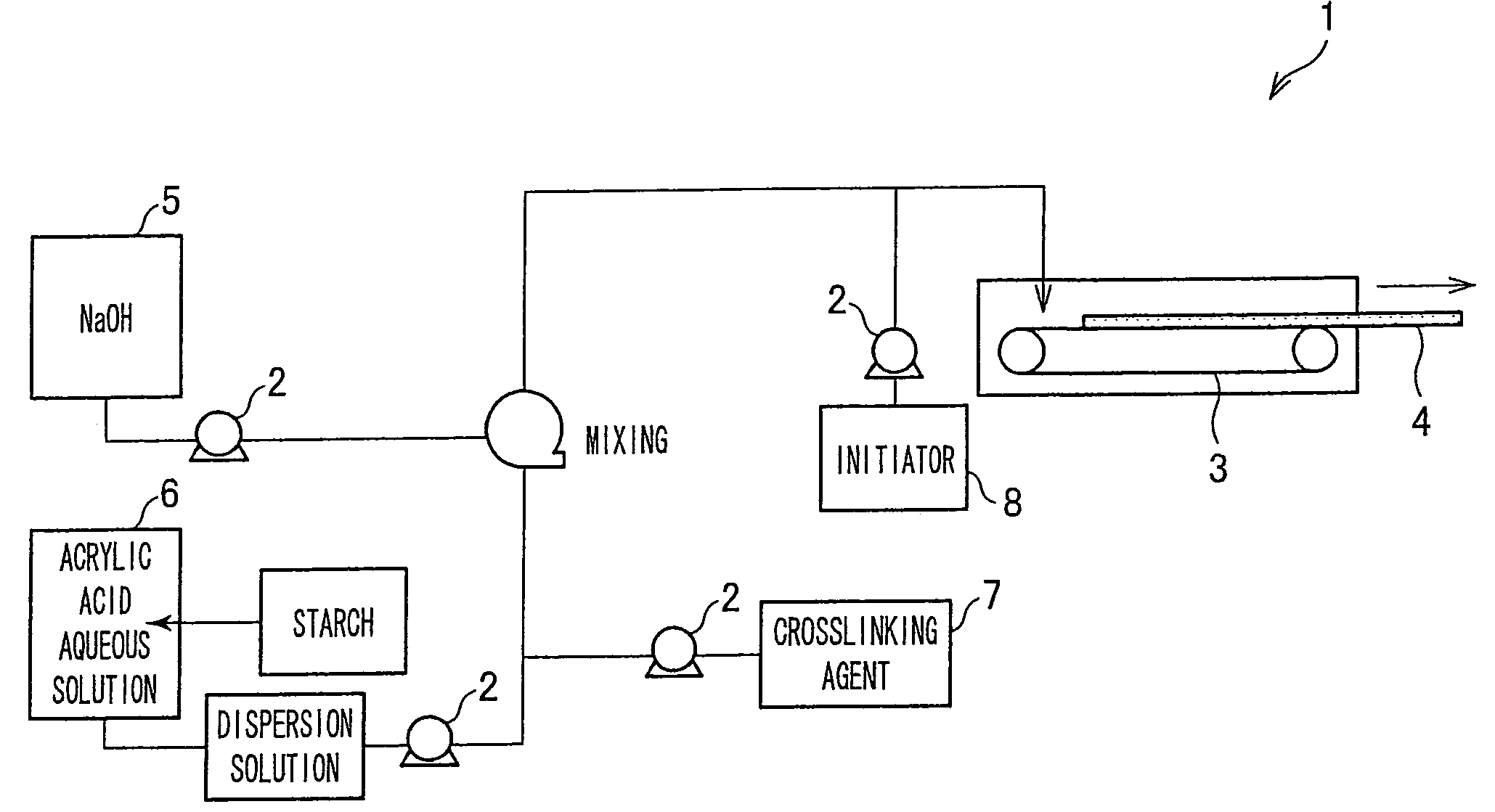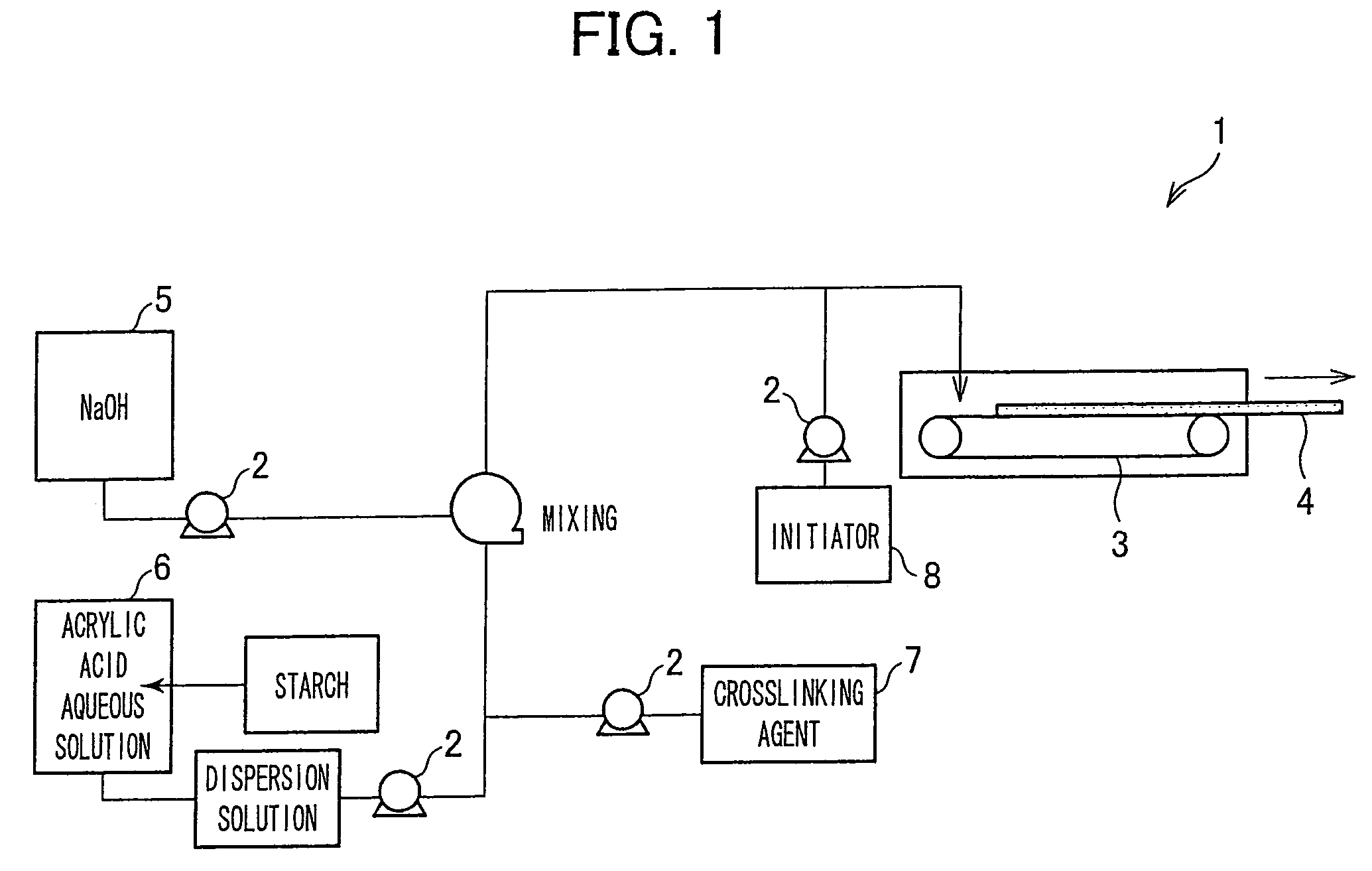Production method for hydrophilic polymer
a hydrophilic polymer and production method technology, applied in the direction of coatings, emulsion paints, etc., can solve the problems of difficult to achieve, extra expense and time, fish eyes, etc., and achieve the effect of high-performance hydrophilic polymer, simplified hydrophilic polymer production step, and improved productivity
- Summary
- Abstract
- Description
- Claims
- Application Information
AI Technical Summary
Benefits of technology
Problems solved by technology
Method used
Image
Examples
example 1
[0127]37.1 parts of acrylic acid, 5.4 parts of 1% polyethylene glycol diacrylate (average molecule mass=522) aqueous solution, and 0.23 part of 1% pentasodium diethylene triamine pentaacetate was mixed together in a 250 ml polypropylene resin container so as to prepare an acrylic acid aqueous solution. The acrylic acid aqueous solution was stirred with a magnetic stirrer, while adding 0.9 part of commercially-available starch (potato starch) so that the starch particles are dispersed, so as to prepare a dispersion solution. Thereafter, 29.7 parts of 48.5% sodium hydroxide aqueous solution and 25.0 parts of water are mixed and heated to about 42° C., and then the mixture solution was further mixed with the foregoing dispersion solution. The mixture solution was immediately heated up by heat of neutralization to 103° C., and the starch particles dispersing therein were immediately dissolved. A monomer aqueous solution for polymerization was thus obtained.
[0128]At the time where the mo...
example 2
[0131]The same experiment as that of Embodiment 1 was carried out except that a polyvinyl alcohol (“Gosenol GH-17” (saponification degree=86.5 to 89.0) provided by NIPPON GOHSEI Co. Ltd.), which passes through a sieve with 212 μm meshes, was used instead of the starch. Obtained was a water-absorbing resin (2). Also in this example, the polyvinyl alcohol was immediately-dissolved in the monomer aqueous solution for polymerization, as with Example 1.
[0132]The particulate water-absorbing resin (2) was observed by an optical microscope, and many tiny bubbles, but less amount than Example 1, were seen therein.
[0133]The absorption ratio and the soluble amount of the particulate water-absorbing resin (2) thus found are shown in Table 1.
example 3
[0134]The same polymerization as that of Example 1 was carried out except that 4.5 parts of “Soluble Starch” (provided by WAKO CHEMICAL Co. Ltd.) was used instead of the starch. As a result, a hydrous polymer was obtained.
[0135]The hydrous polymer was smashed in the same manner as that of Example 1, and was dried by 70° C. hot air for 3 hours, and was further dried in vacuum at 40° C. The dried product was smashed by a bench crusher, and the resulting particles were classified by some sieves. With this, a particulate water-absorbing resin (3) which passed through a 600 μm mesh sieve but was caught by a 300 μm mesh sieve was obtained.
[0136]The absorption ratio and the soluble amount of the particulate water-absorbing resin (3) thus found are shown in Table 1.
PUM
| Property | Measurement | Unit |
|---|---|---|
| temperature | aaaaa | aaaaa |
| temperature | aaaaa | aaaaa |
| temperature | aaaaa | aaaaa |
Abstract
Description
Claims
Application Information
 Login to View More
Login to View More - R&D
- Intellectual Property
- Life Sciences
- Materials
- Tech Scout
- Unparalleled Data Quality
- Higher Quality Content
- 60% Fewer Hallucinations
Browse by: Latest US Patents, China's latest patents, Technical Efficacy Thesaurus, Application Domain, Technology Topic, Popular Technical Reports.
© 2025 PatSnap. All rights reserved.Legal|Privacy policy|Modern Slavery Act Transparency Statement|Sitemap|About US| Contact US: help@patsnap.com


